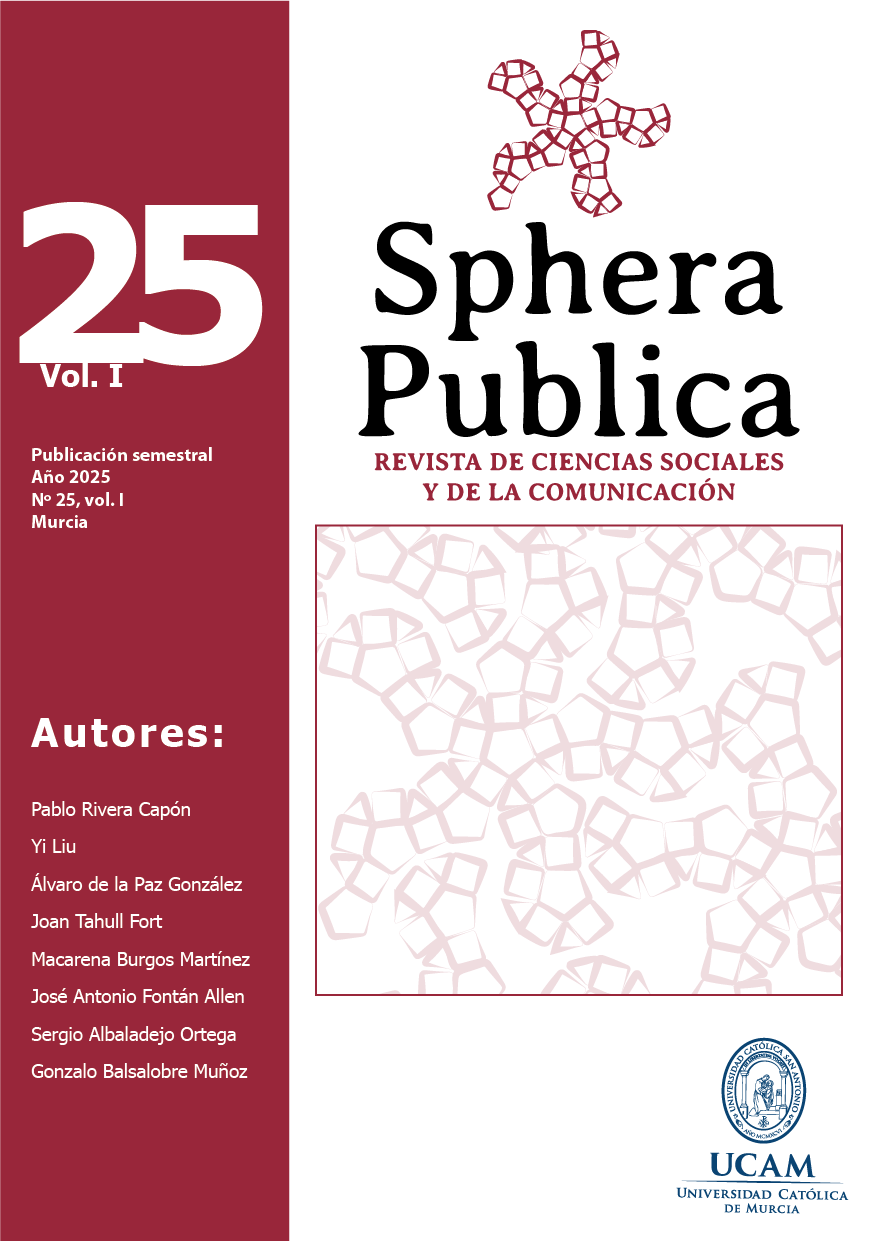Institutional Communication and Digital Participation: An Analysis of the Digital Media and Social Media Strategy of the Provincial Council of Lugo
Análisis de la estrategia de la Diputación de Lugo en medios digitales y redes sociales
Keywords:
comunicación institucional,, análisis mediático, , percepción pública, , estrategia digital, , engagementAbstract
This study analyzes the digital footprint of the Provincial Council of Lugo using a mixed-methods approach that combines content analysis and natural language processing (NLP). A total of 1,331 informational pieces published in digital media, blogs, and social media between July and September 2023 were examined, assessing their reach, tone, and virality. The findings reveal that the Council maintains a significant media presence (estimated audience: 5,160,674 users) and a predominantly positive tone (94.14%). However, differences were observed in message reception: content related to tourism and culture generates a greater impact, whereas institutional communications exhibit lower emotional resonance. Additionally, misalignments were identified between communication planning and information consumption patterns across various digital media and social networks, suggesting the need to optimize the dissemination strategy. Based on these findings, a more flexible communication management approach is recommended, along with the use of more engaging narrative formats and improved content segmentation to enhance citizen engagement across digital platforms.
References
Bertot, J. C., Jaeger, P. T. y Grimes, J. M. (2012). Promoting transparency and accountability through ICTs, social media, and collaborative e‐government. Transforming government: people, process and policy, 6(1), 78-91.
Blumler, J. G. y Kavanagh, D. (1999). The third age of political communication: Influences and features. Political Communication, 16(3), 209-230. http://www.communicationcache.com/uploads/1/0/8/8/10887248/the_third_age_of_political_communication-_influences_and_features.pdf
Bonsón, E., Royo, S. y Ratkai, M. (2015). Citizens' engagement on local governments' Facebook sites. An empirical analysis: The impact of different media and content types in Western Europe. Government Information Quarterly, 32(1), 52-62. https://doi.org/10.1016/j.giq.2014.11.001
Boulianne, S., Borge, R., Dennis, J., Vaccari, C., y Valeriani, A. (2022). Book review: Political participation in the digital technology era: a symposium on Outside the Bubble: Social Media and Political Participation in Western Democracies. Italian Review of Political Science/Rivista Italiana di Scienza Politica, 1-19. https://doi.org/10.1017/ipo.2022.30
Canel, M. J. y Luoma-aho, V. (2019). Public sector communication: Closing gaps between citizens and public organizations. John Wiley & Sons.
Castells, M. (2009). Communication power. Oxford University Press.
Chadwick, A. (2017). El sistema de medios híbridos: Política y poder (2ª ed.). Oxford Studies in Digital Politics. https://doi.org/10.1093/oso/9780190696726.001.0001
Couldry, N. (2012). Media, society, world: Social theory and digital media practice. Polity Press.
Criado, J. I. y Villodre, J. (2020). Delivering public services through social media in European local governments. An interpretative framework using semantic algorithms. Local Government Studies, 47(2), 253-275. https://doi.org/10.1080/03003930.2020.1729750
Criado, J. I., Rojas-Martín, F. y Gil-Garcia, J. R. (2017). Enacting social media success in local public administrations: An empirical analysis of organizational, institutional, and contextual factors. International Journal of Public Sector Management, 30(1), 31-47. https://doi.org/10.1108/IJPSM-03-2016-0053
Criado, J., Pastor, V. y Villodre, J. (2018). Big Data y administraciones públicas en redes sociales. Colección NovaGob, 3, 1-29. https://www.ospi.es/export/sites/ospi/documents/documentos/redes-sociales/NovaGob_Academia_Big_Data_y_AAPP_en_RRSS.pdf
Flick, U. (2018). An introduction to qualitative research (6th ed.). SAGE Publications.
Gálvez-Rodríguez, M. D. M., Sáez-Martín, A., García-Tabuyo, M. y Caba-Pérez, C. (2018). Exploring dialogic strategies in social media for fostering citizens' interactions with Latin American local governments. Public Relations Review, 44(2), 265-276. https://doi.org/10.1016/j.pubrev.2018.03.003
Guess, AM, Malhotra, N., Pan, J., Barberá, P., Allcott, H., Brown, T., ... y Tucker, JA (2023). ¿Cómo afectan los algoritmos de las redes sociales a las actitudes y el comportamiento en una campaña electoral? Science, 381 (6656), 398-404. https://doi.org/10.1126/science.abp9364
Haro-de-Rosario, A., Sáez-Martín, A. y Caba-Pérez, M. del C. (2016). Uso de las redes sociales para mejorar la participación ciudadana con el gobierno local: ¿Twitter o Facebook? New Media & Society, 20(1), 29-49. https://doi.org/10.1177/1461444816645652
Kemp, S. (2023). Digital 2023: Global overview report. DataReportal. https://datareportal.com/reports/digital-2023-global-overview-report
Krippendorff, K. (2018). Content analysis: An introduction to its methodology (4th ed.). SAGE Publications.
López-García, G. (2020). Vigilar y castigar: El papel de militares, policías y guardias civiles en la comunicación de la crisis del Covid-19 en España. El Profesional de la Información, 29(3), e290311. https://doi.org/10.3145/epi.2020.may.11
López-López, P. C., Puentes-Rivera, I. y Rúas-Araújo, J. (2017). Transparencia en televisiones públicas: Desarrollo de indicadores y análisis de los casos de España y Chile. Revista Latina de Comunicación Social, 72, 253-272. https://doi.org/10.4185/RLCS-2017-1164
Martín-Llaguno, M., Berganza, R. y Navarro-Beltrá, M. (2022). Accountability of unaccountable institutions: Oversight of the press, social networks, and the Spanish Parliament over the Spanish king emeritus. El Profesional de la Información, 31(4). https://doi.org/10.3145/epi.2022.jul.17
Mazzoleni, G. y Bracciale, R. (2018). Socially mediated populism: The communicative strategies of political leaders on Facebook. Palgrave Communications, 4, 50. https://doi.org/10.1057/s41599-018-0104-x
Mazzoleni, G. y Schulz, W. (1999). "Mediatization" of politics: A challenge for democracy? Political Communication, 16(3), 247-261. https://doi.org/10.1080/105846099198613
Mergel, I. (2013). A framework for interpreting social media interactions in the public sector. Government Information Quarterly, 30(4), 327-334. https://doi.org/10.1016/j.giq.2013.05.015
Monteagudo, H. (2012). El idioma gallego en la sociedad: La evolución sociolingüística 1992–2008. Galicia 21: Journal of Contemporary Galician Studies, 4, 77-105.
Monteagudo, H. (2017). O proceso de normalización do galego: Avances e perspectivas. Consello da Cultura Galega. https://consellodacultura.gal/publicacion.php?id=314
Pang, B. y Lee, L. (2008). Opinion mining and sentiment analysis. Foundations and Trends in Information Retrieval, 2(1-2), 1-135. https://doi.org/10.1561/1500000011
Rodríguez Andrés, R. (2016). El ascenso de los candidatos outsiders como consecuencia de las nuevas formas de comunicación política y la desafección ciudadana. Comunicación y Hombre, 12, 73-95. https://dadun.unav.edu/bitstreams/7427e594-6ee7-477a-b00a-511e21bdbf84/download
Russmann, U. y Svensson, J. (2017). Introduction to visual communication in the age of social media: Conceptual, theoretical and methodological challenges. Media and Communication, 5(4), 1-5. https://doi.org/10.17645/mac.v5i4.1263
Túñez López, J. M. y García, J. S. (2011). Redes sociales, política y compromiso 2.0: La comunicación de los diputados españoles en Facebook. Revista Latina de Comunicación Social, (66), 213-234. https://doi.org/10.4185/RLCS-66-2011-930-210-234
De Vries, L., Gensler, S. y Leeflang, P. S. (2012). Popularity of brand posts on brand fan pages: An investigation of the effects of social media marketing. Journal of Interactive Marketing, 26(2), 83-91. https://doi.org/10.1016/j.intmar.2012.01.003
Sabate, F., Berbegal-Mirabent, J., Cañabate, A. y Lebherz, P. R. (2014). Factors influencing popularity of branded content in Facebook fan pages. European Management Journal, 32(6), 1001-1011. https://doi.org/10.1016/j.emj.2014.05.001
Zavattaro, S. M. y Sementelli, A. J. (2014). A critical examination of social media adoption in government: Introducing omnipresence. Government Information Quarterly, 31(2), 257-264. https://doi.org/10.1016/j.giq.2013.10.007
Downloads
Published
How to Cite
Issue
Section
License
Copyright (c) 2025 Pablo Rivera

This work is licensed under a Creative Commons Attribution 4.0 International License.
Los autores que publican en esta revista están de acuerdo con los siguientes términos:- Los autores conservan los derechos de autor y garantizan a la revista el derecho de ser la primera publicación del trabajo al igual que licenciado bajo una Creative Commons Attribution License que permite a otros compartir el trabajo con un reconocimiento de la autoría del trabajo y la publicación inicial en esta revista.
- Los autores pueden establecer por separado acuerdos adicionales para la distribución no exclusiva de la versión de la obra publicada en la revista (por ejemplo, situarlo en un repositorio institucional o publicarlo en un libro), con un reconocimiento de su publicación inicial en esta revista.
- Se permite y se anima a los autores a difundir sus trabajos electrónicamente (por ejemplo, en repositorios institucionales o en su propio sitio web) una vez publicado en la plataforma de Sphera Publica, ya que puede dar lugar a intercambios productivos, así como a una citación más temprana y mayor de los trabajos publicados









